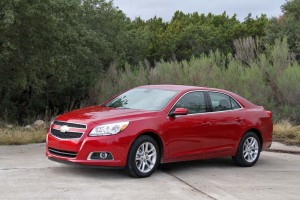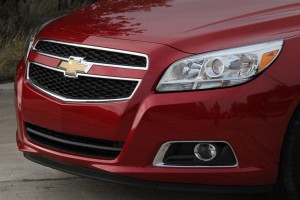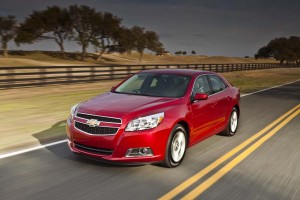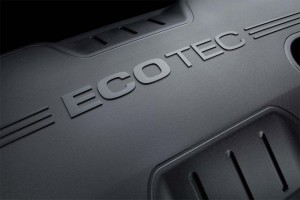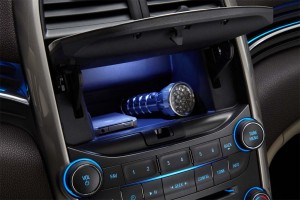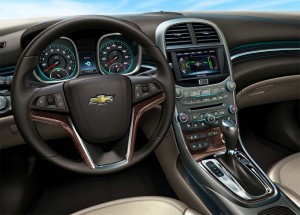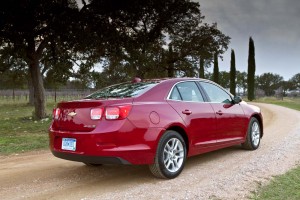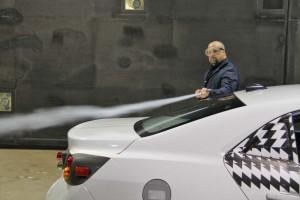There was a time, not all that many years ago, when General Motors owned the American midsize market. But a procession of poorly designed and executed products all but ensured that the Japanese would take command – products like the Honda Accord and Toyota Camry today dominating the critical market segment.
The General began to signal its intent to regain its once-lofty position with the launch of an all-new Chevrolet Malibu in 2008 – the domestic sedan going on to win kudos as North American Car of the Year. Now, Chevy hopes to ramp things up a couple more notches with the launch of the next-generation Malibu.
We headed to Austin, Texas to spend some time in the new midsize sedan – or, more precisely, in the 2013 Chevrolet Malibu Eco. That’s the “mild” hybrid version that will be coming to market in the coming months, with the mainstream version to follow some months later once its all-new 4-cylinder engine is ready for production.
We’ve actually been spending a lot of time with Malibu lately, as regular readers of TheDetroitBureau.com will recall. This is one of the most critical products GM has launched since its 2009 bankruptcy and Chevy has staged a number of background briefings to underscore the effort that has gone into the development of the 2013 Malibu.
It’s not a bad move to come to market first with the Malibu Eco – which borrows the eAssist system that is already in use on several Buick products, including the 2012 LaCrosse, where it is offered as standard equipment. American motorists are clearly more interested in fuel economy than at any time since the last great oil shock of the ‘70s, with perhaps the brief exception of mid-2008, when fuel costs surged to more than $4 a gallon.
This time, the shift in focus appears to be more than temporary. And the 2013 Chevy Malibu should be something that midsize buyers will sit up and take notice of. The new model delivers 25 mpg in City driving and an impressive 37 mpg on the EPA’s Highway cycle. Those are the sort of numbers even compact models were barely able to deliver until recently.
To get there, Chevy engineers have taken a number of critical steps. There’s been an enormous amount of attention paid to aerodynamics. The 2013 Chevrolet Malibu Eco has a drag coefficient of 0.29. If you missed that lesson in school consider that it is only the slightest tick less wind slick than a Chevy Volt plug-in hybrid or the Corvette sports car.
To get there, the maker has taken a number of steps, ranging from the size and shape of the sideview mirrors to the sedan’s high tail with integrated spoiler. There’s even full underbody shielding and the new Malibu Eco integrates active grille shutters that open only when extra air is needed to cool the radiator.
But the real breakthrough is the eAssist system. It has more in common with Honda’s Integrated Starter Assist system than the Toyota Prius’ Synergy Drive – the GM system is what’s known as “mild” hybrid, meaning the Malibu cannot operate on battery power alone. But the system delivers enough of a boost to improve acceleration when you’ve got your foot to floor without sucking down gallons of fuel. And it can level out demand when you’re wandering over the ups-and-downs of Texas Hill Country.
The powertrain features a 2.4-liter inline-four to which a 15 kilowatt electric motor has been paired. Under hard acceleration it will punch out another 15 horsepower and a hefty amount of torque – all told, the package making 182 hp driving the front wheels.
You’re not going to pose much of a threat to the kid in the pony car but it’s reasonably quick, especially in an era when an “Eco” badge means you’re typically not much more than a stone pony. The official 0 to 60 time is 8.7 seconds. But what’s more impressive is the way the eAssist system levels out the way that the 2013 Chevrolet Malibu handles the rest of the driving experience.
There’s far less of the hunt-and-seek behavior by its GM 6T40 6-speed automatic transmission. Unless you’re looking to accelerate hard – or heading up a steep hill – that extra torque from the surprisingly compact electric motor helps the powertrain hold gears.
The system uses a compact, half kilowatt-hour lithium-ion battery, incidentally, the first use of LIon technology in a conventional GM hybrid. The system recaptures energy that would otherwise be lost during braking or coasting. It also permits the new Malibu Eco to offer Auto Start functionality, the engine briefly shutting off when you’re idling, say, at a stoplight. Lift your foot off the brake and it almost imperceptibly fires back up by the time your foot reaches the accelerator pedal.
Along with all the steps Chevy engineers have taken to reduce wind drag they’ve also put a surprising amount of effort into eliminating road and wind noise, as well. The new Malibu is nearly as quiet as its Buick sibling, so much that about the only time the outside world notably intruded was when we drove onto some of the rougher patches of pavement one finds around Hill Country.
Of course, we spent a fair bit of the drive with the new ChevyMyLink system playing our favorite tunes. The infotainment system is the latest from GM and offers an assortment of features, from advanced – and lower-cost – navigation to a surprisingly nice audio package.
If you opt for a new Malibu equipped with the new 7-inch touchscreen display you’ll discover one of the many features that make the new midsize sedan such a pleasant surprise. Tap a button under the LCD monitor and it flips up, revealing a 6-inch-deep storage bin where you can tuck away your iPhone or MP3 player.
The new video display anchors a handsome interior that, a few years ago might have put one of Cadillac’s offerings to shame. We’d put our money down that it is currently the most attractive mainstream offering in the midsize segment, far more handsome and lavish than the corner-cutting cabin of the 2012 Toyota Camry.
The seating of the new 2012 Chevrolet Malibu is plush and comfortable, the front seats proving surprisingly supportive as we charged through some of the tight corners we discovered on our route through the country outside Austin.
On the downside, the rear seating is a bit cramped, though acceptable. But if back seat legroom is what will make or break your decision it doesn’t match up to the likes of the new Volkswagen Passat.
Going from inside-out, the overall look of the new Malibu is the most handsome we have ever seen in the form of a mainstream GM midsize sedan. A marked improvement from the already attractive outgoing model, it is a visual stand-out that drew stares wherever we drove.
The face is gently rounded, with the 2013 Malibu introducing a revised and more appealing version of the familiar Chevy crossbar grille – which designer Steve McCabe suggests will be “the new, globally recognized face of Chevrolet.”
If you pick up a few styling cues from the wildly popular Chevy Camaro, such as the rear taillamps, well, that’s purely intentional. The new sedan features a more coupe-like silhouette, and its added 3-inch width translates into both more shoulder room for passengers and a more planted rid.
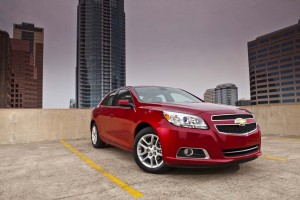
The Malibu Eco will be followed, later next year, by two new powertrains, including a 2.0-liter turbo.
You feel that working your way around the Texas hills. The new Malibu may not be a sports car, but despite its Eco badge it handles the tightest turns and whoop-de-dos with surprising aplomb.
One interesting move by Chevy engineers was to counter the loss of tire stickiness with the Eco’s low-rolling-resistance rubber by going with tires that are a half-inch wider.
Meanwhile, the modified electric power-steering system is much more precise than before with a surprisingly good road feel. This model may be geared for fuel economy but it is a lot more fun to drive than most of the standard-issue models now in the midsize segment. Compared to the supposedly sporty Toyota Camry SE we’d opt for the Malibu, which doesn’t struggle when you steer it into a sharp corner.
For those who don’t care about achieving maximum mileage you’ll next to wait about a half year for GM to finish up development of its new 2.5-liter I-4. That non-hybrid model should still deliver about 30 miles per gallon or better on the highway, however.
The maker will also add a new 2.0-liter turbo package, the engine essentially the same as the 270-hp powertrain that will be going into the more luxurious Cadillac ATS sedan coming to market later next year.
It’s been a long time since Chevrolet dominated the midsize market. And it will face some tough competition as it rolls out the various versions of the new Malibu – with both Ford and Honda set to introduce their update Fusion and Accord models, respectively, in the coming year. But if the first version of the 2013 Chevrolet Malibu is any indication we expect GM’s largest brand to start regaining ground quickly – and efficiently, thanks to the Eco’s new eAssist drivetrain.

